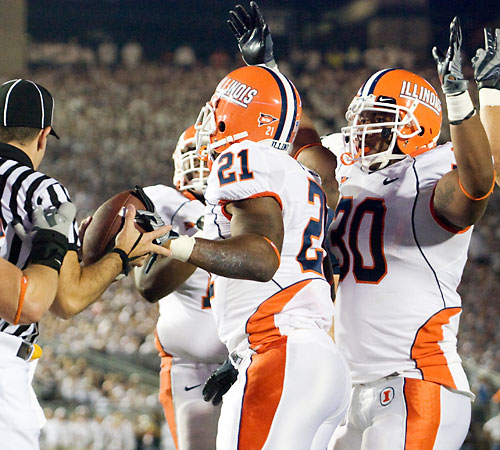Offenses match up in Big Ten rival game

ason Ford hands the football to a referee after his touchdown against Penn State at Beaver Stadium on Saturday. Erica Magda
October 3, 2008
When Joe Tiller became the head coach of Purdue in 1997, he became the first coach in the Big Ten to employ a full spread offense. Tiller said there were doubters as to whether the system could work in the latter months of the season in the Midwest, given the less than pass friendly conditions. But 11 years later, the system is now more or less employed by every team in the Conference and, as Tiller said, is something that has touched every conference in America.
“It really is, I guess, enlightening when you look back at it and see it,” Tiller said in his weekly press conference Tuesday. “It certainly was a different style of play than the league was used to, and, actually, we enjoyed a honeymoon there for a couple of years before all these defensive coaches got together and started scheming.”
While Tiller’s offense is less spread-option based than Illinois, head coach Ron Zook adapted his system to what he hated to see the most as a former defensive coach.
“I did it because I don’t like to defend,” Zook said. “The tempo, being able to go fast and so forth, those are the things, as a defensive coach, caused me the most issues and problems. That’s the reason we did it and not any other reason than that.”
Until Zook joined the program before the 2005 season, Illinois had been a pro-style offense under Ron Turner, relying on pass protection, blocking and the running game – more so than different formations to create favorable match-ups.
Get The Daily Illini in your inbox!
“But I think quite frankly it was something that was inevitable,” Tiller said of the Big Ten’s infatuation with the system. “It was only a matter of time.”
This past year, Michigan was one of the last bastions for football purists, parading tall, slow, prototypical passing quarterbacks – the likes of Tom Brady, Elvis Grbac and Jim Harbaugh – sauntering in the pocket, working through progressions. Rich Rodriguez then had a messy split with West Virginia and came to Ann Arbor, Michigan, only to bring a culture-shocking system to the Wolverines. By now, the spread offense was reaching the coasts of college football, fostering a change for Michigan that was something Rodriguez found necessary when he started to first run the system approximately 18 years ago.
“A lot of people talk about the spread in all levels, even in the NFL they’re starting to do some versions of it,” Rodriguez said in his Tuesday press conference. “There’s no patents on schemes. I don’t think that there’s one scheme that is the scheme to run. I think it is whatever that you feel as a coaching staff gives you the best chance to have success, what you can recruit to and develop and what you need to have an answer to the various teams on your schedule.”
Zook and his coaching staff acknowledge that both the Illinois and the Michigan systems are extremely similar. Being that there are only so many variations, the coaches admit there are only so many combinations.
“There are some things that are very, very similar and everybody’s got their own flavor that they add to it,” Zook said. “There’s a lot of similarities. Right now, the thing about them is that, wherever you’re at, you’re going to utilize the personnel that you have. They probably play a little bit more (than the) 20-personnel that we are, which is three wide outs and two backs.”
Co-defensive coordinator Dan Disch further explained the 20-personnel system.
“It’s a little more shotgun option out of a the two-back (formation),” Disch said. “It’s the split back stuff that you see our guys doing sometimes. You’ll have a pitch back, instead of just the quarterback and the dive back, they have the pitch back to it.”
Michigan was able to show off its offense last week against then-No. 9 Wisconsin, scoring all 27 of its points in the second half after allowing 19 in the first half. The Illini players didn’t get to see all of the game, only the first half from their hotel rooms, and were shocked when they heard the final.
“I was watching the game in the hotel and saw that Michigan was down, and I was talking with my mom after the game and she told me that Michigan won, I didn’t believe it,” defensive tackle David Lindquist said. “I saw a bunch of turnovers, and I didn’t think there was anyway that these guys were going to win. Wisconsin just seemed to be dominating. To me, the fact that Michigan only gave up 19 points in the first half was incredible because they were turning the ball over too much. That shows how well their defense played and how their offense recovered.”
But even with all the talk of Michigan, their spread and the possibility of a progressing quarterback, Disch was only worried about one thing going into the game against the Wolverines.
“We’ve got to worry about ourselves more than Threet right now,” Disch said. “We’ve got to be sound and stop the run and not give up any big plays.”






